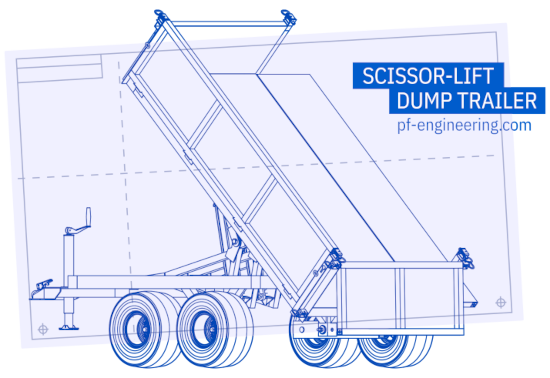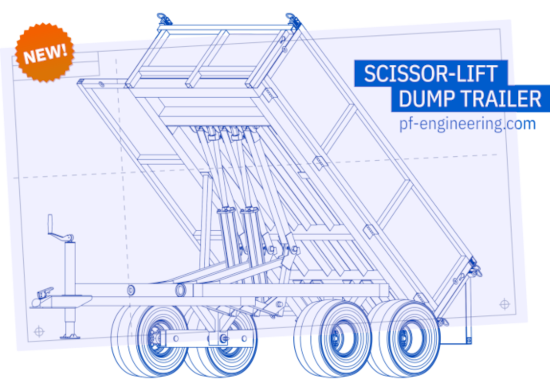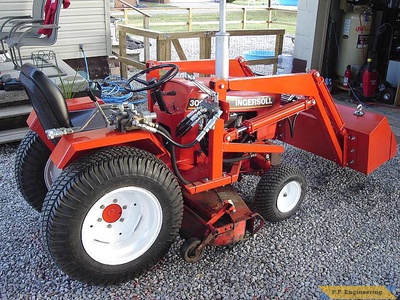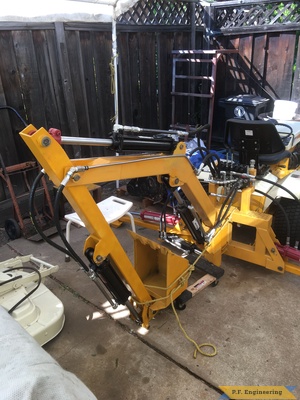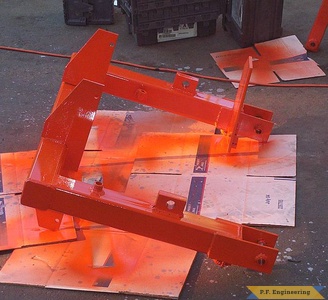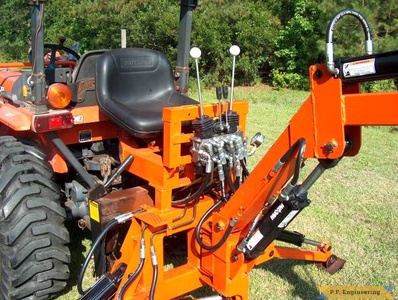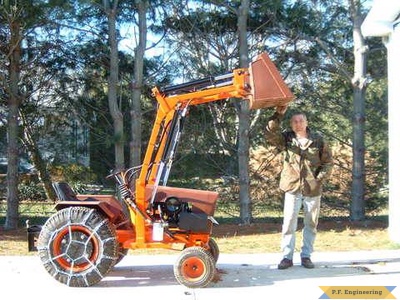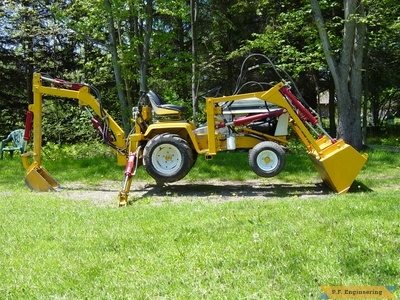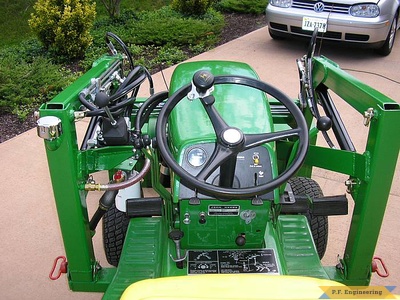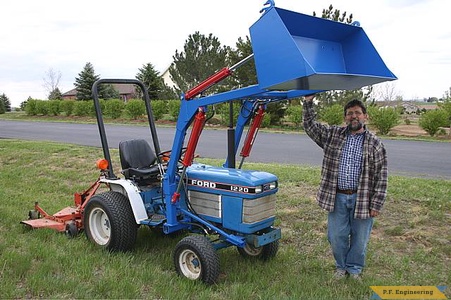Scissor-lift Dump Trailer
Build a custom dump trailer with our specially designed plans
The bed-lift mechanism on this trailer is our unique hybrid design that combines the best aspects of a straight-cylinder lift with the benefits of a scissor lift, giving you more extension with a shorter cylinder, plus increased power during the most difficult part of the lift cycle — the start.
If you look closely at the first video of our prototype (Oct. 15, 2021), the lower scissor brackets remain stationary, resting on the cross member, for the first 12" of the lift. This allows the cylinders to progress from their initial 30-degree lift-angle to 50 degrees before the scissor brackets begin lifting off the frame’s cross member. This takes all the stress off the scissor-pivot linkages during the most stressful part of the lift, and it gives the cylinders a good positive angle to work with right from the start. It also allows us to use fairly low hydraulic pressure with small bore (2.5") hydraulic cylinders, which increases the longevity of the hydraulic system and parts. The old garden tractor I used in the videos to lift 3000 lbs of stone only produces 800 psi, the maximum being at 2 GPM.
Testing the prototype with about 3000 lbs of stone
Another unique aspect of this lift design is that it is modular, meaning that you can have two hydraulic cylinders and three brackets, or one hydraulic cylinder and two brackets, or you can separate these into two units and have one cylinder and two brackets on each side of the dump body, or pretend you’re Alan Millyard and have as many cylinders and brackets put together as you have room for! Lol.
Why A Gas Engine?
Why did I use a gas engine to power this hydraulic system instead of a 12-volt DC power pack? Probably the biggest reason was that I already had a spare vertical shaft lawn mower engine hanging around, who doesn’t? This made the system more cost-effective for me. In the design stage I saw the opportunity to create a built-in oil reservoir in the front frame member of the trailer that allows for a good amount of oil to be gravity fed to a hydraulic pump mounted between the frame rails on the tongue of the trailer. My feelings are that a gravity fed pump is safer to operate, easier to maintain and will live longer than one mounted above the level of oil in the reservoir.
First Video Post: October 15, 2021
Another reason was performance. Even a small 2 to 4 gallon per minute hydraulic gear pump driven by a gas engine will put out twice the flow of a 12 volt DC hydraulic unit, meaning that the dump bed will raise and lower at a more reasonable speed. The geometry of my hybrid scissors-lift design enables this hydraulic dump to be operated at a much lower pressure than most dump trailers require, so a higher pressure electric hydraulic unit is not needed.
A third reason is that the individual components of my hydraulic system are separated and easier to repair or change out if needed. An electric 12 volt DC hydraulic unit is all-in-one with the motor, pump, controls and oil reservoir being combined into one unit. This saves space, but if your pump goes bad it may mean replacing the entire unit instead of just replacing one component of a system that has separate parts available at a reasonable cost.
Also, an engine driven system with separate components has upgrade possibilities. For example, the control valve can be one, two or three spools or more, or have a “power beyond” port on it that gives you the opportunity to add another separate control valve to the system for operating hydraulic cylinders “beyond” the dump lift, so you can power anything you like. If you would like to install a hydraulic Jib crane arm for lifting heavy things onto the dump bed you can add this to your existing hydraulic system very easily.
Features of the Scissor-lift Dump Trailer
- It can be used with tractor hydraulics of 700-800 psi or with self-contained trailer hydraulics
- It has a “hybrid” lift design, combining a straight cylinder lift with a scissor lift
- It uses a tandem-axle “walking beam” suspension for rough terrain
- Its deck height is 24" off the ground for easy hand loading and unloading
- The bed holds 29 cubic feet of material level with the top of its sides
- The bed raises to a 50-degree dump angle
- The bed size is 40" x 78" x 16" tall and 78" x 78" with sides folded down
- The plans contain all necessary details for setting up an engine driven hydraulic system
- The tailgate can be hinged from top or bottom or removed completely
- Tires run outside the dump bed width for better suspension travel
Estimated Cost & Specifications
| Imperial | Metric | |
|---|---|---|
| Trailer weight: | 850 pounds | 386 kg |
| Weight carrying capacity: | 3000 pounds (1.5 tons (US)) | 1361 kg |
| Dump capacity: | 3000 pounds (1.5 tons (US)) | 1361 kg |
| Dump bed size: | 40" x 78" x 16" | 1116 mm x 1981 mm x 406 mm |
| Dump bed capacity: | 1.07 cubic yards (yd³) / 28.9 cubic feet | 818 liters (L) |
| Onboard hydraulic system | ||
| Fold-down side gates and removable tailgate | ||
| Hydraulic scissors lift with a pair of 2.5" bore cylinders | ||
| Walking beam suspension | ||
| Estimated cost to build: | $2000 (Before COVID*) - using tractor’s on-board hydraulic system $2400 (Before COVID*) - using an external add-on hydraulic system |
* Since the start of the COVID-19 pandemic, prices for steel vary considerably from one place to another place.
